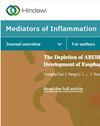Integrative Analysis of Clinical and Bioinformatics Databases to Reveal the Role of Peripheral Innate Immunity in Kawasaki Disease
IF 4.4
3区 医学
Q2 CELL BIOLOGY
引用次数: 0
Abstract
Kawasaki disease (KD) is an immune-response disorder with unknown etiology. KD is an acute systemic immune vasculitis caused by infectious factors that can be complicated by coronary artery lesions. Innate immune cells are closely associated with KD onset, but we know little regarding the expression of immunity-related genes (IRGs) and the possible immune regulatory mechanisms involved in KD. In this study, we analyzed public single-cell RNA sequencing (scRNA-seq) and microarray data of peripheral blood mononuclear cells from normal controls and KD patients. The results of scRNA-seq revealed myeloid cells, T cells, B cells, NK cells, erythrocytes, platelets, plasma cells, hematopoietic stem cells, and progenitor cells in the peripheral blood of patients with KD. In particular, myeloid cells were expanded and heterogeneous. Further analysis of the myeloid cell population revealed that monocytes in KD exhibited higher expression of the inflammatory genes S100A8, S100A9, and S100A12; furthermore, CD14+CD16+ monocyte clusters were associated with inflammatory responses. Microarray data revealed that activation of the innate immune response contributed to KD development and progression. Differential expression and weighted gene coexpression network analysis identified 48 differentially expressed IRGs associated with response to intravenous immunoglobulin, currently the most effective treatment of KD, although numerous patients are resistant. Protein–protein interaction analysis identified ten hub genes (IL1R1, SOCS3, IL1R2, TLR8, IL1RN, CCR1, IL1B, IL4R, IL10RB, and IFNGR1) among the IRGs. In addition, the expressions of IL1R1, SOCS3, CCR1, IL1B, and IL10RB were validated in Chinese KD patients using the real-time reverse transcriptase-polymerase chain reaction. Finally, we found that the neutrophil/lymphocyte ratio could be used as a biomarker to predict responsiveness to intravenous immunoglobulin in KD. In conclusion, our data highlight the importance of innate immunity in KD pathogenesis and its potential in predicting treatment response.临床和生物信息学数据库的综合分析揭示外周先天免疫在川崎病中的作用
川崎病是一种病因不明的免疫反应性疾病。KD是一种由感染因素引起的急性全身性免疫性血管炎,可并发冠状动脉病变。先天性免疫细胞与KD发病密切相关,但我们对免疫相关基因(IRGs)的表达和KD可能涉及的免疫调节机制知之甚少。在这项研究中,我们分析了来自正常对照和KD患者外周血单个核细胞的公开单细胞RNA测序(scRNA-seq)和微阵列数据。scRNA-seq结果显示,KD患者外周血中存在髓系细胞、T细胞、B细胞、NK细胞、红细胞、血小板、浆细胞、造血干细胞和祖细胞。特别是骨髓细胞扩增且呈异质性。对骨髓细胞群的进一步分析显示,KD中的单核细胞表现出更高的炎症基因S100A8、S100A9和S100A12的表达;此外,CD14+CD16+单核细胞簇与炎症反应相关。微阵列数据显示,先天免疫反应的激活有助于KD的发展和进展。差异表达和加权基因共表达网络分析确定了48个与静脉注射免疫球蛋白反应相关的差异表达IRGs,静脉注射免疫球蛋白是目前治疗KD最有效的方法,尽管许多患者具有耐药性。蛋白-蛋白互作分析鉴定出IRGs中的10个枢纽基因(IL1R1、SOCS3、IL1R2、TLR8、IL1RN、CCR1、IL1B、IL4R、IL10RB和IFNGR1)。此外,采用实时逆转录聚合酶链反应验证了中国KD患者中IL1R1、SOCS3、CCR1、IL1B和IL10RB的表达。最后,我们发现中性粒细胞/淋巴细胞比率可以作为预测KD患者静脉注射免疫球蛋白反应性的生物标志物。总之,我们的数据强调了先天免疫在KD发病机制中的重要性及其在预测治疗反应方面的潜力。
本文章由计算机程序翻译,如有差异,请以英文原文为准。
求助全文
约1分钟内获得全文
求助全文
来源期刊

Mediators of Inflammation
医学-免疫学
CiteScore
8.70
自引率
0.00%
发文量
202
审稿时长
4 months
期刊介绍:
Mediators of Inflammation is a peer-reviewed, Open Access journal that publishes original research and review articles on all types of inflammatory mediators, including cytokines, histamine, bradykinin, prostaglandins, leukotrienes, PAF, biological response modifiers and the family of cell adhesion-promoting molecules.
 求助内容:
求助内容: 应助结果提醒方式:
应助结果提醒方式:


